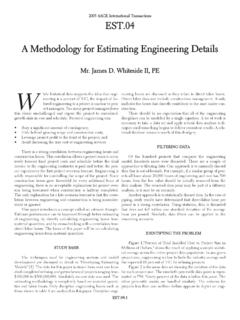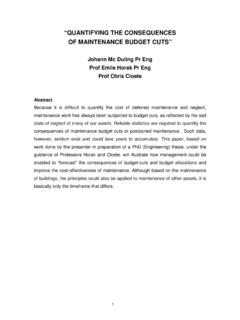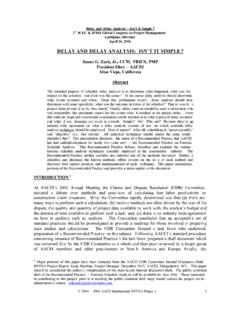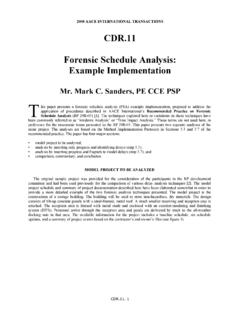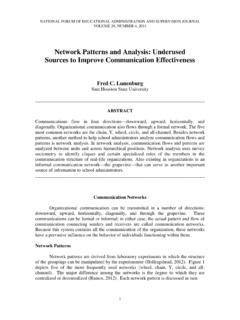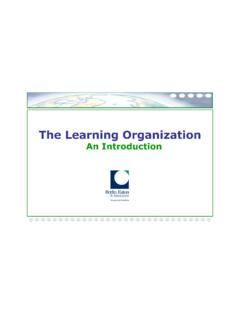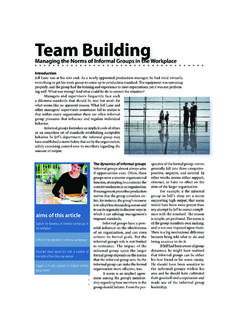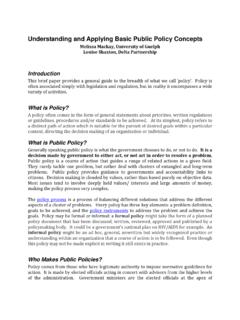Transcription of PROJECT STAKEHOLDER CONCERNS AND …
1 PROJECT STAKEHOLDER CONCERNS AND. expectations . Alexia Nalewaik 1 and Anthony Mills 2. 1. QS Requin Corporation, Pasadena, California, USA. 2. School of Architecture and Built Environment, Deakin University, Geelong Australia ABSTRACT. The objective of the research was to develop a deeper understanding of how STAKEHOLDER expectation varies on capital projects. The focus was on developing new knowledge about governance frameworks and how they influence projects. The data was collected from a sample of interviews of stakeholders associated with construction projects. One implication from this study was that the CONCERNS , risk tolerance, and expectations of the STAKEHOLDER varied according to their position and role in the PROJECT organization.
2 The question became one of what was desired by these stakeholders to address their CONCERNS about management and delivery of projects. As a step towards developing a management and reporting framework, this paper studied STAKEHOLDER expectations in the context of STAKEHOLDER role and PROJECT performance. This research contributes to both PROJECT governance and PROJECT management through a more clarified interface between these two spheres. Stakeholders have certain expectations regarding the efficiency, economy and effectiveness of monies spent on these projects, and they rely on oversight mechanisms to report PROJECT status. The paper offers practical help to those involved in developing or improving governance frameworks for projects, and new insight in the interplay between STAKEHOLDER groups and management functions.
3 KEYWORDS: PROJECT management; PROJECT performance; reporting; risk; stakeholders INTRODUCTION. On every PROJECT , there are seemingly countless internal and external stakeholders, each of which has different needs, opinions, and roles. Much research has been done in the area of identifying and categorizing these stakeholders, and their levels of power and influence, and communicating or interacting with them to the benefit of the PROJECT . The CONCERNS , risk tolerance, and expectations of the STAKEHOLDER vary according to their position and role in the PROJECT organization. These stakeholders will have different levels of interest and investment (both financial and non-monetary) in PROJECT outcomes.
4 Each STAKEHOLDER likely has specific CONCERNS about the management and delivery of the PROJECT . In order to understand how different STAKEHOLDER groups define PROJECT performance or success, and to develop appropriate reporting which addresses the CONCERNS of these STAKEHOLDER groups, this research considered PROJECT success from the different perspectives of a subset of individual internal stakeholders, and identified their top CONCERNS . Discussion about those CONCERNS led to conclusions about how they could impact PROJECT performance. LITERATURE REVIEW. There are many different approaches to defining stakeholders. Some place considerable emphasis on fiduciary or contractual obligations (Orts and Strudler, 2002).
5 Others, such as (Freeman, 1984), consider a STAKEHOLDER to be any group or individual who can affect or is affected by the achievement of the organization's objectives. For the purposes of this paper, we adopt the definition by (Bourne and Walker, 2005), in which stakeholders are . individuals or groups who have an interest or some aspect of rights or ownership in the PROJECT , and can contribute to, or be impacted by, the outcomes of the PROJECT .. The list of stakeholders on a PROJECT can be substantial, including: employees, contractors, suppliers, governing bodies, financiers, clients and end users, the general public, unions, special interest groups, and even future generations.
6 Some of these STAKEHOLDER groups will have more influence than others, due to the nature of their relationship to the PROJECT and Owner. The list of stakeholders with which the PROJECT team invests time and energy is thus often narrowed down to those who have the greatest ability to positively or negatively impact the PROJECT . Literature from the PROJECT Management Institute (PMI, 2008) indicates that PROJECT stakeholders typically comprise a PROJECT manager, the customer / end user, performing organizations (the firms whose employees directly participate in realizing the PROJECT ), PROJECT team members, the PROJECT management team, PROJECT sponsor, other people of influence, and the PROJECT management organization (PMO).
7 The most popular approach to managing stakeholders is to categorize them into several groups depending on their relative position in the PROJECT , level of involvement in the PROJECT , or legal relations between them and the PROJECT . PROJECT -specific stakeholders may include the PROJECT sponsor, end users, client (Owner), and core PROJECT team members, together with community, shadow' team members (people who have informal relations with the PROJECT ), and external groups (Walker 2003). However, stakeholders may also be defined in a more granular fashion. This particular research focuses on four subsets of internal stakeholders. Such stakeholders have an official or contractual relationship with the PROJECT or organization (Winch, 2004) or are directly involved in decision-making processes for the PROJECT or organization (Atkin and Skitmore, 2008).
8 (Rowlinson and Cheung, 2008) further divide stakeholders into classes of upstream stakeholders (customers and end users), downstream stakeholders (contractors and suppliers), external stakeholders (independent concerned parties and general public), invisible stakeholders, and PROJECT stakeholders (champion and delivery team). (Moodley et al, 2008). divide stakeholders into explicit stakeholders (owners and others with direct financial interests), implicit stakeholders (end users), implicitly recognized stakeholders (government and community), and other unknown stakeholders. Because stakeholders can affect PROJECT outcomes, the definition of PROJECT success needs to be understood from the perspectives of different STAKEHOLDER groups, and should also consider the varying levels of interest and investment in PROJECT outcomes by different stakeholders (Newcombe, 2003).
9 The definition of PROJECT success may vary from STAKEHOLDER to STAKEHOLDER , and may even conflict; depending on which STAKEHOLDER perspective is considered, a PROJECT may conceivably be both a success and a failure at the same time (Nalewaik, 2011). The organization must therefore adopt a STAKEHOLDER perspective when focusing on PROJECT outcomes (Nalewaik, 2011). (Walker & Bourne, 2005) identified different kinds of potential STAKEHOLDER influence and impact on projects, such as efforts to cancel the PROJECT , change an aspect of the PROJECT , affect PROJECT scope, sway technical direction, reduce funding, or require specific reporting. Stakeholders can and will impact projects in both positive and negative ways.
10 Because STAKEHOLDER support is crucial to PROJECT success, these concepts have become a key tenet in PROJECT management. Here, we define PROJECT management as the process of adapting the specifications, plans, and approaches to the different CONCERNS and expectations of the various stakeholders (PMI, 2008). The hierarchy of stakeholders creates a network of interdependencies, accountability, and obligations (Nalewaik, 2011). Members of the PROJECT team tasked with delivering the PROJECT have a responsibility to appropriately advise and inform stakeholders, and they presumably have the experience and knowledge by which to do so (Morledge, 2010).


